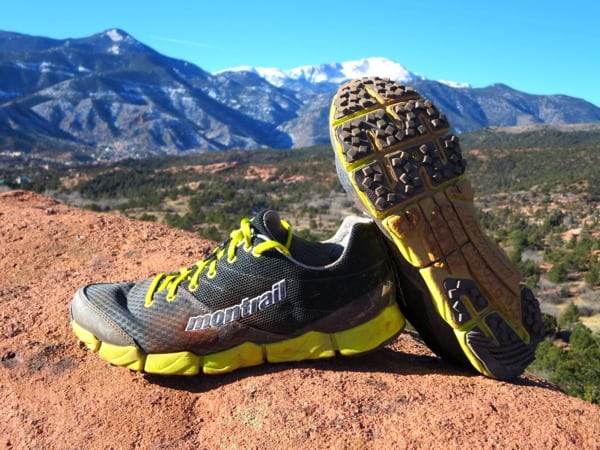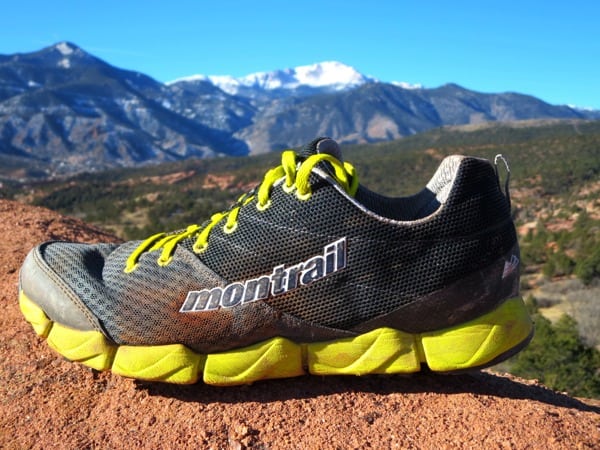Our Favorite Trail Running Shoes
Check out our Best Trail Running Shoes article to learn about our current favorite trail running shoes!
Montrail FluidFlex 2 Review
My relationship with trail running shoes usually comes in one of three forms. The first being that I receive shoes to test and they grow on me gradually over time and I come to enjoy their features for certain types of running, wearing them one or two times per week. The second form is when I immediately dislike a shoe and decide not to review them at all. The third type of review is love right out of the box. Usually, these are shoes that I wear to the exclusion of all others and I will undoubtedly race in them quite a bit in the coming season. The Montrail FluidFlex 2 ($90) meets criteria for this third type of shoe.
Back in July of 2013, I reviewed the original FluidFlex and I had minimal criticism for this hybrid-style trail shoe which feels great both on the roads and the trails. Montrail made just a few tweaks to the original which improve the fit of the upper while maintaining a very smooth and well-cushioned ride in a lightweight (8.3-ounce/238g) package.

The Montrail FluidFlex 2.
Montrail FluidFlex 2 Upper
In my critique of the original FluidFlex, I discussed the curious fit of the upper and wrote that the fit of the shoe was:
“…undermined by a bit of a tapered shape which took my feet some time to get used to. Barely noticeable, this taper may place some pressure on runners’ pinky toes, and while I didn’t have any problems I would hope that this design feature is improved in future editions.”
Montrail did indeed fix this bit of a curvature to the upper which fits incredibly well. The FluidFlex 2 has a snug-fitting heel cup and the rest of the shoe expands from there with a medium fit through the midfoot and a wider toe box. Though it runs true to size for my size 9.5, I appreciated a little extra room in front of my toes to accommodate thicker running socks for winter. Runners who like tight-fitting shoes may want to size down a half size.

The Montrail FluidFlex 2’s lateral upper.
The materials and construction of the upper are more substantial in the FluidFlex 2, with increased durability in high-wear areas. This is accomplished by using a less-airy mesh through the heel and midfoot which is reinforced on the medial side of the shoe by welded-on overlays to improve the midfoot fit. A softer, dual mesh is sewed on the front third of the shoe over the metatarsals and toes which provides more breathability and protection in high-wear areas. This improvement has been greatly appreciated as the very breathable mesh of the original FluidFlex became a bit brittle with wear.
A very snug heel cup is reinforced with padding on either side of the Achilles tendon and the simplicity of this upper gives it a phenomenal fit which will work for a lot of different foot types. Montrail also shortened the laces to a more reasonable length that gives more than enough lace for using the extra eyelet (I did) and still double knot the shoe. As far as I can tell, the extra 0.7 ounces comes entirely in the form of the extra upper material which was warranted in the design.
Midsole
For those of you that haven’t tried Montrail’s FluidFoam, what you can expect is a low durometer (read: softer) compression-molded EVA foam which is surprisingly resilient and durable. I compare the feel of the FluidFoam to Nike’s Lunar foam, but I think that the FluidFoam is a better, longer-lasting product. For runners looking for a lot of soft cushioning in a lightweight package, this is probably your shoe.

The Montrail FluidFlex 2’s medial upper.
One interesting feature of the FluidFlex is that the footbed is pretty flat and not contoured like many lightweight designs. This makes your foot work a little bit harder, especially on steep climbs, and I’ve returned from a few longer runs feeling like the muscles in my arch got a great workout. In my opinion, this is a good thing as it can improve foot strike, foot strength, and probably one’s form, but I would recommend a little transition. Montrail kept the drop the same as the original, at 4-5 millimeters, and the FluidFlex 2 has an excellent transition and trail feel which will be most appreciated by mid/forefoot strikers. It is also extremely flexible due to grooves spaced throughout the midsole and has very little torsional rigidity which would make it a poor choice for runners with stability needs.
Another feature missing from this shoe is a rock plate, and due to the fairly thick midsole cushioning, it is not needed. I have well over 100 miles on this pair, and I pretty much killed my last pair of FluidFlex with about 500 miles on them. I have yet to experience a bone bruise or even severe pain due to a sharp rock, but there is certainly enough ground feel and proprioception to warrant care over really rocky ground.
Outsole
The FluidFlex 2 employs the same outsole pattern as on Montrail’s Rogue Racer and Bajada models. I’ve grown to love this grippy outsole as it doesn’t get in the way on the roads or non-technical trail and it grips with the best of them in dry conditions. Due to the wintery conditions I enjoyed in November and December, I also was able to test them on packed snow and icy conditions. I was surprised that the small lugs were able to grip into packed, and sometimes slippery, snow and on icy conditions this Gryptonite outsole did about as well as anything. While the FluidFlex 2 would not be my first choice in mud, the shallow lug patterns do shed mud and clay easily.
It does seem strange that Montrail chose to leave the Fluid Foam exposed in the midfoot area of the outsole, and it does show some significant wear. However, the outsole of the original FluidFlex had the same design and it lasted for the life of the shoe.

The Montrail FluidFlex 2’s outsole.
Overall Impression
The FluidFlex 2 is a minimal shoe with the additional cushioning not normally found in minimalist trail shoes. Some runners may feel bothered by the softer feel of the FluidFoam and may fall victim to the thought that you’re losing out on energy return by wearing a softer midsole. For those runners looking for the responsiveness of something like a Hoka in a lightweight and very flexible package then the FluidFlex 2 gets the nod. As of now, most of the other trail shoes in my collection feel stiff and heavy in comparison and only road shoes have the same smooth transition to them. I also don’t think there is a better hybrid shoe on the market for those of us that hit both roads and trails in a single outing.
The only question remaining is whether or not the FluidFlex 2 can handle 100 miles in one go, which is completely in the foot of the beholder. With the recent tweaks made to the upper I would be willing to try, and they are a more than worthy 50k to 100k shoe. With the early racing season looming on the horizon, I will likely be hitting the starting line for my first few 50ks in the FluidFlex 2, and I think that a lot of runners will be pleasantly surprised if they give this lightweight trail runner a try which will be available on February 1, 2014.
[Author’s Note: Variable widths were not offered in the original FluidFlex nor will they be in the second version.]
